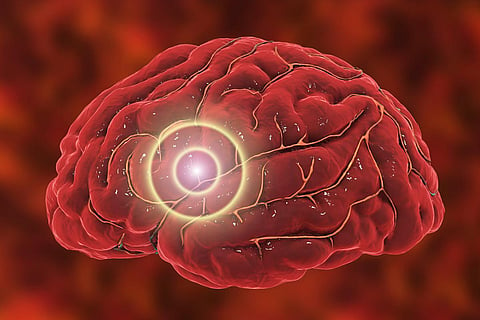A stroke is an injury to the brain caused by an interruption in blood flow from a vessel blockage, blood clot or vessel rupture. There are two main types of stroke: ischemic stroke and hemorrhagic stroke.
The most common type of stroke is called an ischemic stroke, or your doctor may say “ischemic infarct (stroke).” Ischemia means lack of blood supply, which may result in tissue damage because of the lack of oxygen and nutrients. Therefore, an ischemic stroke is caused by an interruption of blood flow to the brain from a blocked blood vessel due to plaque (buildup of fatty deposits) or a blood clot. Once the blood vessel is blocked, it is like clogged plumbing. If blood cannot get to the brain for a period of time, that region of the brain becomes injured, resulting in a stroke that produces symptoms.
The other type of stroke is called a hemorrhagic stroke and accounts for approximately 10-15% of all strokes. Hemorrhage is defined as acute loss of blood from a damaged blood vessel. In this case, a blood vessel in the brain leaks or breaks open, spilling blood into the brain and resulting in injury and producing symptoms.
How can I recognize symptoms of a stroke?
The signs and symptoms of a stroke are related to how the brain is organized. Since the left side of the brain controls the right side of the body and the right brain controls the left side of the body, the symptoms occur suddenly and typically involve one side of the body. Because it is impossible to predict which part of the brain may be involved with a stroke, a range of symptoms are possible, including:
Numbness or weakness of face, arm or leg, especially on one side of the body
Confusion, trouble speaking or understanding speech
Trouble seeing in one or both eyes
Trouble walking, dizziness, loss of balance or coordination
Severe headache with no known cause
It is extremely important to know the signs and symptoms of a stroke. To help remember the symptoms of a stroke, it helps to know the acronym BE FAST.
B is for BALANCE. Sudden loss of balance or coordination.
E is for EYES. Sudden blurred, double vision or loss of vision.
F is for FACE. Sudden face drooping or numbness.
A is for ARM. Sudden weakness or numbness of the arms or legs on one side of the body.
S is for SPEECH. Sudden slurred speech, inability to speak or difficulty to understand.
T is for TIME. A stroke is an emergency, so call 911 immediately.
Is a stroke an emergency?
Yes, a stroke is considered an emergency. The saying “time is brain” highlights the importance of a prompt assessment and treatment to try to prevent irreversible injury to the brain. As every minute goes by without the brain getting the appropriate blood, 1.9 million brain cells die, resulting in permanent injury and potential disability.
As the Director of the Stroke Center at Mount Sinai West and Mount Sinai Morningside, I can share some good news about treatment: There is now effective treatment to try to reduce the risk of a significant stroke and permanent disability.
Treatment opportunities are time-dependent though, so if anyone develops signs and symptoms of a stroke, 911 should be called immediately to ensure the person is taken to the closest emergency department for a rapid assessment and appropriate treatment.
What happens when you call 911 for stroke symptoms?
When someone calls 911 and says “I’m having a stroke,” the call is treated as an emergency, and the emergency medical service (EMS) team is mandated to take the person to the closest emergency department with a specialized team to care for stroke patients.
In the emergency room, a series of tests and assessments need to be performed to determine whether a specific patient is eligible for acute stroke therapy. Depending on several factors—including the time the symptoms began, medical history and the results of testing—doctors may be able to administer certain therapies, including a powerful intravenous blood thinner to improve blood flow to the brain.
On some occasions, specialized physicians may determine it is necessary to go into the artery to remove the blockage and improve blood flow to the brain. The procedure is an endovascular intervention (in the blood vessels) and is performed using a cerebral (brain) angiogram. An angiogram is a diagnostic procedure that allows the creation of images of the blood vessels (like a map) using X-rays. By using the map, a catheter can traverse the arteries to the point of the blockage with the goal of unblocking the clogged artery by pulling out the blood clot.
Successful treatment of stroke patients requires a multidisciplinary team with specialized skills to diagnose and treat patients rapidly to improve the chances of a good outcome.


